Most
of the hull designs on these pages are ones that were successful during
the time period of from 1950 to 1975. Opinions vary about their successfulness,
but the fact that people were trying anything that would 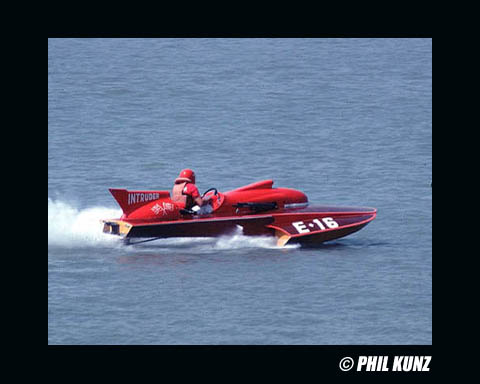 give their particular
hull design a competitive advantage is historically worth mentioning. Books
could be written oncertain designers such as Henry Lauterbach, who has
over 200 documented hulls he designed and built over a 40 year period.
Some builder/designers handcrafted less than 2 or 3 hulls during their
lifetime.
Varying backgrounds of each of these builders probably played a role in
the way they were built, but one thing they all must of had in common was
a love of woodworking. give their particular
hull design a competitive advantage is historically worth mentioning. Books
could be written oncertain designers such as Henry Lauterbach, who has
over 200 documented hulls he designed and built over a 40 year period.
Some builder/designers handcrafted less than 2 or 3 hulls during their
lifetime.
Varying backgrounds of each of these builders probably played a role in
the way they were built, but one thing they all must of had in common was
a love of woodworking.
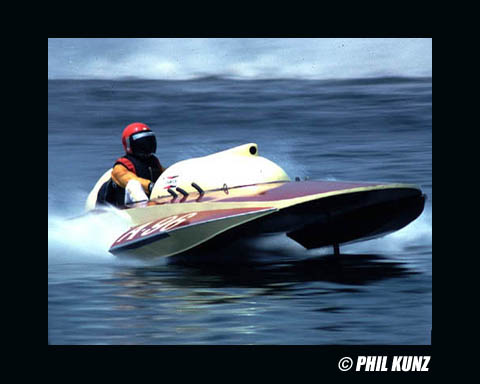 Each builder must have believed that their hull
would have an uniqueness of special characteristics that would make their
hull faster and different from the others.There are abundant stories you
will hear about the characteristics of a particular hull. Each builder must have believed that their hull
would have an uniqueness of special characteristics that would make their
hull faster and different from the others.There are abundant stories you
will hear about the characteristics of a particular hull.
Different theories on such items as the placement of the sponsons on the
hull, angles on the chines, the beam width at the front, middle, and aft
section and how those dimensions flow into the right combination for speed
in the straightaways and the turns. 
Each hull would be tweaked trying to
find the ultimate agility, responsiveness, and total overall handling needed
by the driver to be the first across the line. Some hull ideas worked,
some did not.
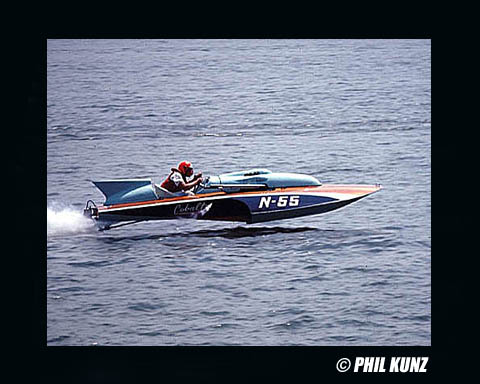
Prior to the late 1960's, the round nose 3-point hydroplane design was
dominant. This design was basically patterned off the Slo-mo-shun IV that
Ted Jones designed and Anchor Jensen built. This hydroplane shattered the
world water speed record, then the egos of its competition when in debuted
in the unlimited ranks in 1952. From then on, all the style designs of
hydroplanes basically adopted this design. 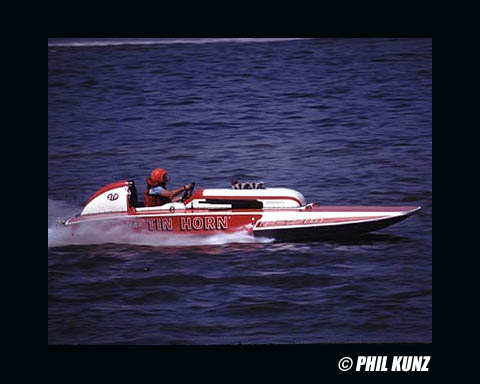 Even the stepped, displacement
V-hulls (the original "hydroplane") which were an improvement over the
conventional V-hulls, with having their "notched" out steps in the bottom
of the hull, were no match for the 3-point hydroplane. Even the stepped, displacement
V-hulls (the original "hydroplane") which were an improvement over the
conventional V-hulls, with having their "notched" out steps in the bottom
of the hull, were no match for the 3-point hydroplane.
This
style of hull would literally fly over the water and therefore eliminate
the water resistance problem. With their propeller about 50% out of the
water, huge amounts of water would be displaced into the air behind the
racing craft creating the famous roostertail that was associated with these
hydroplanes.  With most round nose hydroplanes, the motor was in the front
and the driver was seated behind the motor in the rear of the hull with
the drive shaft running underneath the driver. With most round nose hydroplanes, the motor was in the front
and the driver was seated behind the motor in the rear of the hull with
the drive shaft running underneath the driver.
No seat belts were
worn by the drivers, with
the thinking that in case of a blowover, if would be wiser to be thrown
from the hull, than to be strapped into a wood craft that could literally
disintegrate upon contact with the water.
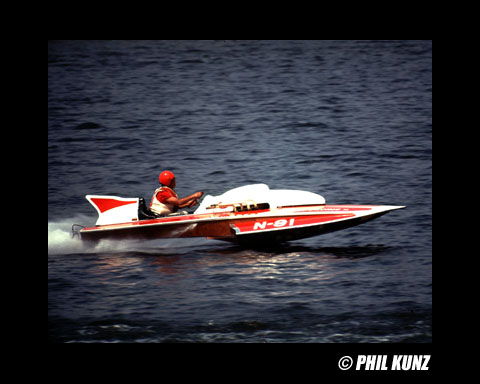 These
builders all contributed to the different styles and looks you see in vintage
hydroplanes. These gentlemen would make hydroplane modifications, adding,
subtracting, moving and refining the many angles that grace these racing
machines. Another item worth noting that these men were also very good
boat racers. This on-hands experience I'm sure attributed to the many major
and minor distinctions you see between the different names in the hydroplane
raceboats. These
builders all contributed to the different styles and looks you see in vintage
hydroplanes. These gentlemen would make hydroplane modifications, adding,
subtracting, moving and refining the many angles that grace these racing
machines. Another item worth noting that these men were also very good
boat racers. This on-hands experience I'm sure attributed to the many major
and minor distinctions you see between the different names in the hydroplane
raceboats.

Using
experience from racing and testing, they would try to improve and build
into their designs any hull requirement they thought would be needed to
win. Changes and modifications were construction techniques, different
framing types, fastening systems, plywood thickness selections, driveshaft
angle, and motor placement. I'm sure many of the driver/owners were also
pitching in their 2 cents worth with reports on water conditions on the
different courses in the regions. These handling characteristics of the
different hydroplane designs and the new changes would spread between the
racers. All these new changes eventually evolved into hydroplane hull styles
we see today.
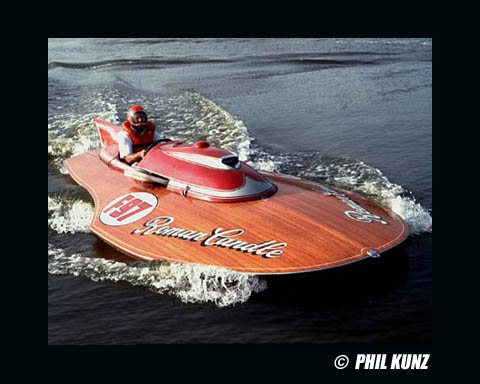
Look
closely at vintage hydroplanes. Other than the major discrepancies among
the different hydroplane builders, you can see very subtle variations.
If you attend a vintage raceboat event and see them sitting in the pits
side by side, these differences can be quite noticeable, even to somebody
who may not specifically be looking for them. There lies the beauty of
the different designs we see from one designer to the other. 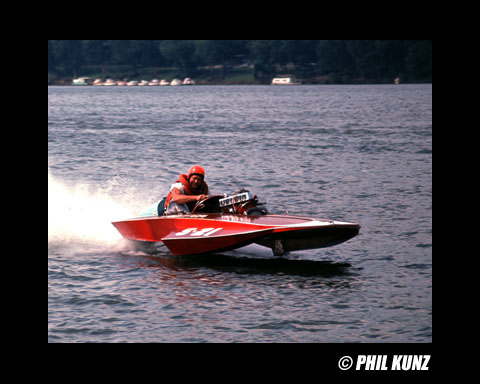 But with so
few of these hydroplanes that have survived to this time today, photographs
can be the only evidence in quite a few instances where people are trying
to document or acquire a rare piece of racing history. But with so
few of these hydroplanes that have survived to this time today, photographs
can be the only evidence in quite a few instances where people are trying
to document or acquire a rare piece of racing history.
The
3-point hydroplane hull itself (if you can imagine the raceboat without
its sponsons attached) has been described as to an aircraft wing. The upward
slope of the bottom towards the nose provides the lift needed to plane
the hull above the water and on a cushion of air. Hence the name hydroplane.
These are basically low flying aircraft with a flying ceiling of a few
feet. 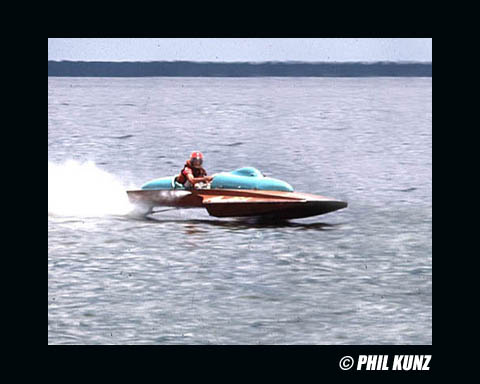
The top deck shape would be the
equilibrium providing enough air pressure resistance to keep the hull maintaining
its altitude especially at the higher speeds. The sponsons are the pontoons
mounted to each side of the hull which helps keep the hull balanced as
it crosses the water. The propeller, as on a airplane, provides the thrust
to keep it airborne. 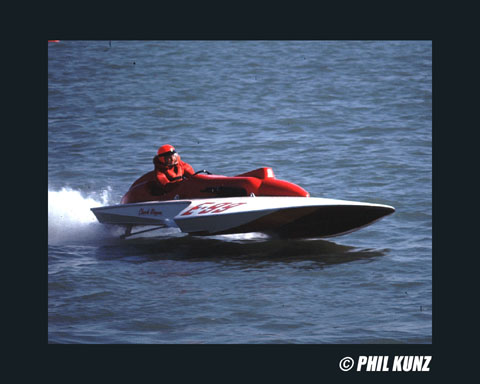
The term 3-point hydroplane derives from the actual contact of the hull
to the water once it achieves enough speed to plane the hull on the cushion
of air. The 3 points that the hydroplane balances on as it skips across
the water being the first point of contact, the propeller, and the other
2 points being the ends of each sponsons. Interesting enough, decades went
by while boat racers kept trying to increase speed by increasing horsepower
to overcome the friction of the water. 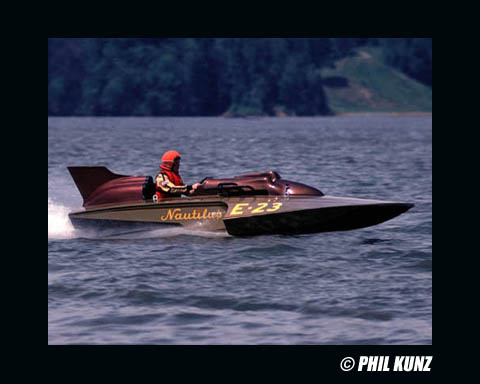 There isn't anything built by man
that achieves what the hydroplane performs as it skips across the water
surface. There isn't anything built by man
that achieves what the hydroplane performs as it skips across the water
surface.
The
combination of all these principles becoming the unique experience we see
when you view one of these incredible craft. The sound of the open headered,
inboard engine, coupled with a high flying hull, and add about one ton
of water being displaced into the famous roostertail behind these machines
puts them atop anything I have ever experienced. The sheer eloquence as
they twist through a turn and the edge of the sponson kicks up another
roostertail has to be seen first hand to be appreaciated. 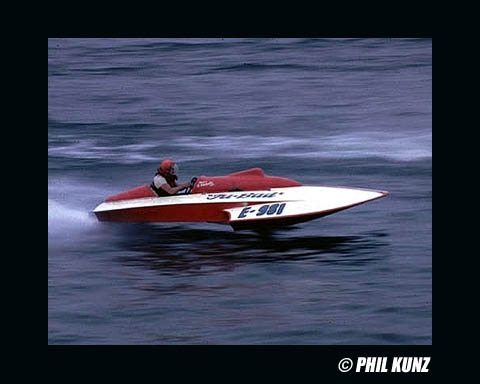
The hydroplanes throughout these
pages are the feat of engineering achieved its rich history. Quite an acheivement
considering the lack of computer modules that could have spewed forth some
of that information today.
The
foredeck of the different hull designs would include shapes on the crown
of the deck in order to find the optimum altitude of the hull throughout
its flight, whether it be the straightaways or turns. Proper placement
of weight being placed into the hull such as the motor, gas tank, battery,
and driver all combined to influence its attitude (proper weight distribution
for an even keel) and handling characteristics. Many competitive races
would be decided on these factors in matches where driver skills were comparable. 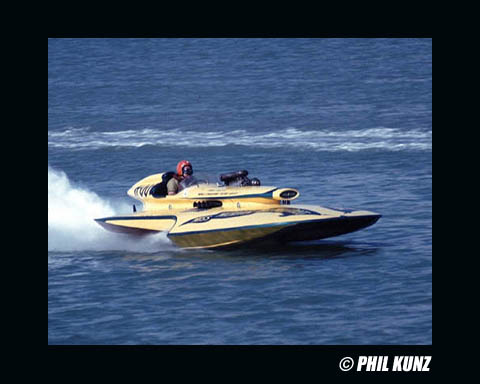
That is why a good driver was always looking for the right combination
in their hull to give them the best advantage possible. Just building the
right combination of proper placement of these items could be the difference
between a winner and loser. Considerations of the minimum weight restrictions
had to be followed. Considerations of extra weight was equally important.
This would be evident in time trials and on the kilo and 1-mile speed trap
runs. The straightaway records and heat records could be affected if you
were a heavy individual. 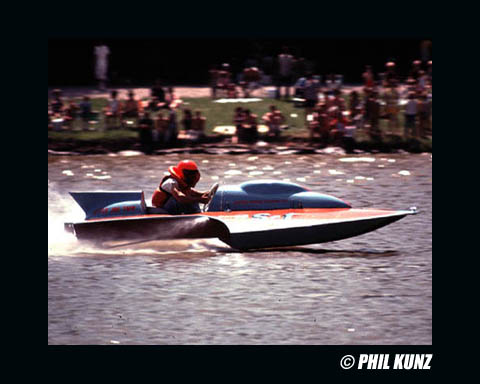
Times
and records broken could be inched up throughout a summer season. Every
little thing would be looked at. As with any racing endeavor, weight reductions
and maximum engine revolutions, even as minute as it may be seen, was closely
looked at. Superchargers were allowed in certain classes, but one had to
pay attention to the extra weight that was going to be incorporated into
the hull. Also, supercharged engines would need to carry additional fuel
that would be needed to feed the higher gas consumption used by a supercharged
engine.
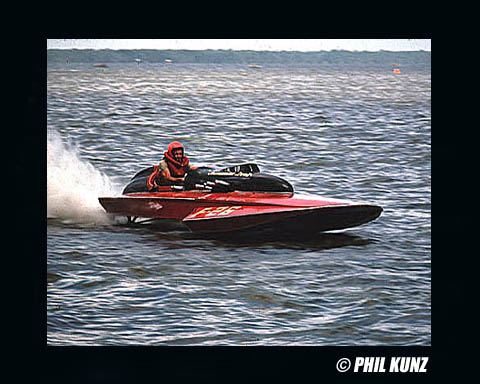 The drivers would experiment with the gasoline blends trying to find the
specially brewed formulation using alcohol and nitro introduced to increase
horsepower. Any horsepower robbing items would be eliminated. Experimentation
was a rule of thumb. Engines would be tweaked between heats trying to fine-tune
their motors for every ounce of power available. Getting back to the hull
details, you will notice different transoms width and height that vary
from one design to another. The reasoning of these features are debatable
but time has already proven the winners and losers in these respects. The drivers would experiment with the gasoline blends trying to find the
specially brewed formulation using alcohol and nitro introduced to increase
horsepower. Any horsepower robbing items would be eliminated. Experimentation
was a rule of thumb. Engines would be tweaked between heats trying to fine-tune
their motors for every ounce of power available. Getting back to the hull
details, you will notice different transoms width and height that vary
from one design to another. The reasoning of these features are debatable
but time has already proven the winners and losers in these respects. 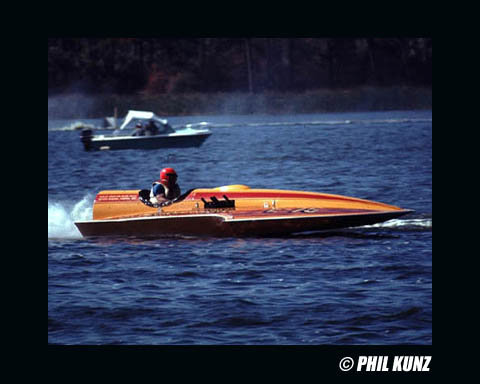
Innovation was the rule. Refinements were proven or disproven throughout
the summer racing season, some stuck, others were quickly thrown out. Others
yet would be refined, until they were proven right. These are some of the
reasons why it is great to go to a vintage event and see the stages of
evolution throughout the history of the different racing periods. Some
items might have worked in a smaller class, but would not work in a larger
class. Many factors influenced the subtle changes.
But as with most ideas, when a designer would try to improve on one aspect
of the hull, he could effect the good qualities and purpose and possibly
compromise other qualities and features. 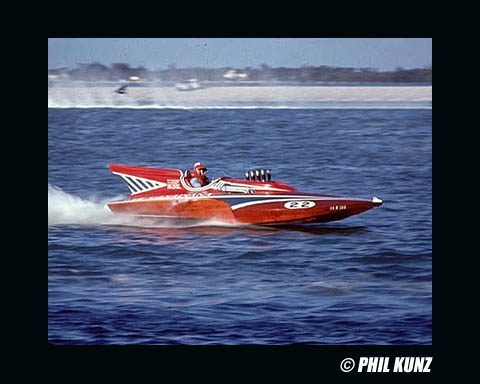 Many a hulls were probably built
with good intentions only to be dismissed after a few races. I'm sure you
would get many an arguments with the designers on that subject. But whether
it was a proven winner or not, any racing hydroplane left around today
is a winner in my mind and worth being preserved. Hopefully, any left or
found today will survive the ax or firepit, and some good soul with invest
the time and money to bring it back to its original form for the pleasure
of all of us. Many a hulls were probably built
with good intentions only to be dismissed after a few races. I'm sure you
would get many an arguments with the designers on that subject. But whether
it was a proven winner or not, any racing hydroplane left around today
is a winner in my mind and worth being preserved. Hopefully, any left or
found today will survive the ax or firepit, and some good soul with invest
the time and money to bring it back to its original form for the pleasure
of all of us.

The
sponsons were the main idea that made the hydroplane a reality. You would
have to go all the way back to when Ventnor Boats Works had the original,
basic idea of attaching water skis on the front of a conventional displacement
V-hull to plane the hull up and out of the water. The success of this idea
quickly caught on and soon many raceboats were incorporating this thinking
into their hulls. Then the Ted Jones design of a 3-point hydroplane, first
used on Slo-mo-shun IV, rewrote the basic hull look we are seeing throughout
this article. 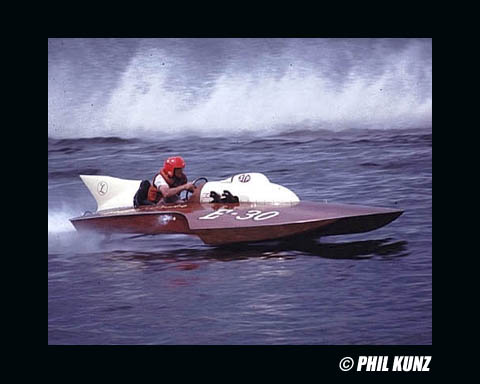 Ted Jones always believed that the top of the sponsons should
flow into the foredeck, were as some of other raceboat designers such as
Henry Lauterbach, Will Farmer and Rich Hallet, built their sponsons that
were offset from the foredeck. Ted Jones always believed that the top of the sponsons should
flow into the foredeck, were as some of other raceboat designers such as
Henry Lauterbach, Will Farmer and Rich Hallet, built their sponsons that
were offset from the foredeck.
Different
lengths, angles, heights, widths and placement of sponsons were tried throughout
history. First, there were the wet sponsons that was the rule, then the
exception. Dry sponsons (they would not fill with water) then became the
rule. Dry sponsons would aid the hull with buoyancy. But all these changes
contributed to the individual beauty of these racing hydros. 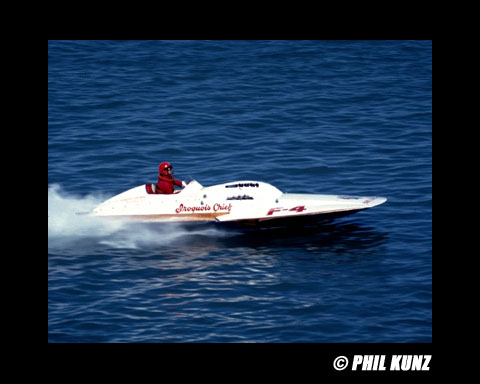
The cowlings were being built with
different shapes that would have lines to improve aerodynamics and help
with stability. A fin built into the rear cowling was from the thought
of helping stabilize the aft of the hull. Arguments can be made about the
effectiveness of this idea.
There
were also evolutions with regards to the "mechanicals" of a limited class
hydroplanes. The skid fin which aids the cornering of the craft in the
turns, was originally attached to the underneath of the hull inside the
starboard sponsons. Somebody moved the skid fin out further and angled
it slightly which was found to further aid the hull in the turns.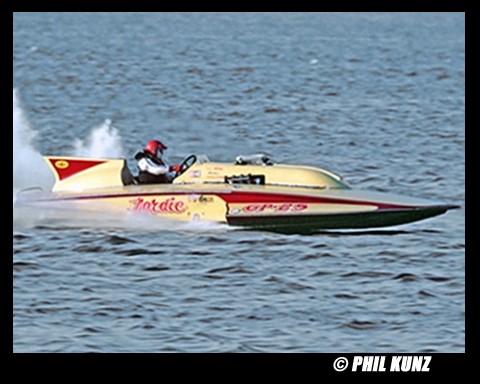
Another improvement was moving the 2 water pickups which were attached
to the ends of each of the sponsons to a single pickup that was attached
to the very bottom edge of the rudder. The water being picked up from this
location was much cleaner and eliminated the one-way valves that needed
to be used for the sponson water pickups. As you can see in this photo,
there are many times when the sponson edges would be out of the water,
which would interrup the water flow to the engine.
 A
dividing point in the history of the inboards was the cab-over which started
being successful during the late 1960s. A few racers, (not builders) took
regular conventionals and moved the cockpit up in front of the motor. Two
of the conventionals that were converted were a Dick Sooy and Henry Lauterbach
design. There may have been more of them. A
dividing point in the history of the inboards was the cab-over which started
being successful during the late 1960s. A few racers, (not builders) took
regular conventionals and moved the cockpit up in front of the motor. Two
of the conventionals that were converted were a Dick Sooy and Henry Lauterbach
design. There may have been more of them.
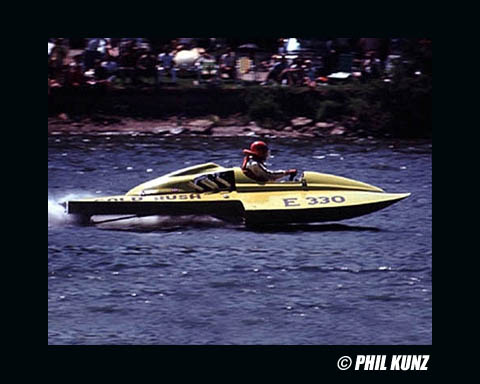 The
picklefork styled hydroplanes, with the driver in front (and currently,
usually enclosed in a capsule), and the motor behind him, started making
inroads in the late 1960's. In about 1963, Ron Jones started building round
nosed cab-overs which stayed that way until about 1966, when shallow pickelforks
were tried. The
picklefork styled hydroplanes, with the driver in front (and currently,
usually enclosed in a capsule), and the motor behind him, started making
inroads in the late 1960's. In about 1963, Ron Jones started building round
nosed cab-overs which stayed that way until about 1966, when shallow pickelforks
were tried.
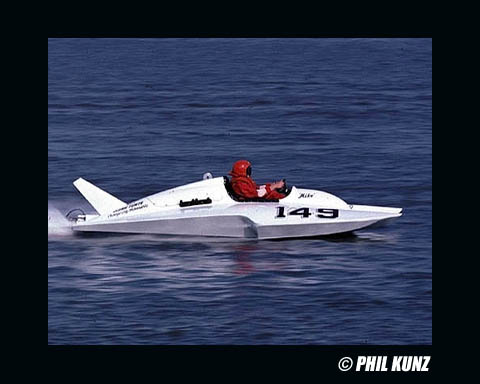 This
was the beginning of the end of the traditionally styled, round nosed 3-point
hydroplane with the driver seated in the aft of the hull that everybody
was accustomed to seeing for about twenty-five years. During the early
1970's, the pickelforks on these racing hulls got deeper and became quite
popular. They started dominating in most classes by 1977. But the conventionals
weren't going away without a fight. Builders of the conventional hydroplanes
such as Lauterbach, Farmer, Hallet, Milosivich, Karelson and Staudacher
started making their transoms wider. This
was the beginning of the end of the traditionally styled, round nosed 3-point
hydroplane with the driver seated in the aft of the hull that everybody
was accustomed to seeing for about twenty-five years. During the early
1970's, the pickelforks on these racing hulls got deeper and became quite
popular. They started dominating in most classes by 1977. But the conventionals
weren't going away without a fight. Builders of the conventional hydroplanes
such as Lauterbach, Farmer, Hallet, Milosivich, Karelson and Staudacher
started making their transoms wider.
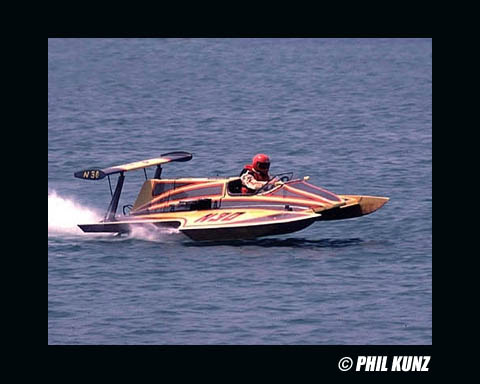 This
idea helped keep those designed conventionals in the win columns right
up to the late 1970's. Only in the extremely fast Grand Prix class did
the Lauterbachs hold their own up until 1989. This
idea helped keep those designed conventionals in the win columns right
up to the late 1970's. Only in the extremely fast Grand Prix class did
the Lauterbachs hold their own up until 1989.
These unique differences and evolution's
only add to the wonderful history of the sport of Hydroplane Racing.

The personality of handcrafted,
vintage hydroplane raceboats will remain as long as the spirit of vintage
hydroplane racing is kept alive through the next generation. The former
owners, drivers, designers, and builders of these racing crafts will be
remembered for their innovation and skill through the documentation, preservation
and restoration efforts of these unique flying hulls.
|

